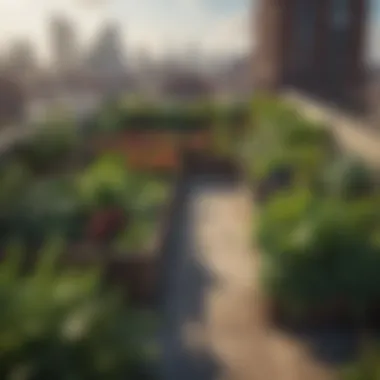Urban Gardening for Beginners: A Comprehensive Guide


Intro
Urban gardening has emerged as an essential practice for those keen to cultivate their own green spaces within the confines of city life. As residents of metropolitan areas increasingly seek connection with nature, urban gardening provides not only a practical means of food production but also an opportunity to enhance one’s living environment. Beginners can find solace in growing their own herbs, vegetables, and flowers, making use of limited space and sometimes scarce resources.
This comprehensive guide aims to navigate the often intricate world of urban gardening, addressing both fundamental principles and actionable techniques. It covers essential tools, suitable plants, and best practices tailored to suit the limitations and opportunities found in urban settings. By diving into this topic, individuals can learn how to effectively engage with their surroundings while fostering a sustainable lifestyle.
The relevance of urban gardening extends beyond individual benefits. It promotes ecological balance and enhances urban biodiversity, offering a natural remedy to the concrete landscape prevalent in cities. Moreover, it addresses food security concerns, empowering city dwellers to take charge of their food sources.
Embarking on this journey might seem overwhelming, but the satisfaction derived from nurturing plants is rewarding. As we progress through this guide, practical advice will be provided to facilitate a smooth start for aspiring urban gardeners. Let’s explore the features that can significantly enhance your gardening experience.
Understanding Urban Gardening
Urban gardening is an essential topic for modern urban dwellers wishing to enhance their living environments through green practices. This form of gardening not only allows individuals to grow their own food but also facilitates a deeper connection with nature amidst concrete surroundings. Understanding urban gardening lays the groundwork for beginners to appreciate the various elements involved—such as space utilization, plant selection, and resource management.
Defining Urban Gardening
Urban gardening involves cultivating, processing, and distributing food in and around urban areas. This practice can take numerous forms, including community gardens, rooftop gardens, and vertical gardens. The essence of urban gardening lies in its adaptability to limited space, making it possible for individuals to engage in gardening despite living in densely populated areas.
Benefits of Urban Gardening
Urban gardening offers several benefits that cater to both individual and community needs.
Health and Nutrition
One of the key aspects of health and nutrition in urban gardening is the access to fresh produce. Growing fruits, vegetables, and herbs at home enables individuals to consume healthier foods. This direct engagement with horticulture encourages better eating habits. A major benefit of cultivating your own food is the control over pesticides and fertilizers, allowing for organic cultivation, which leads to a healthier diet. Urban gardening encourages a lifestyle of wellness.
Environmental Impact
The environmental impact of urban gardening cannot be overstated. Gardens contribute to biodiversity in urban areas, providing habitats for various species, including pollinators. Furthermore, they improve air quality by absorbing carbon dioxide and releasing oxygen. Another significant characteristic of urban gardens is their role in reducing urban heat, as plants help to cool the surrounding environment. This aspect plays a crucial role in combating climate change effects in cities.
Cost-Effectiveness
Cost-effectiveness is a notable feature of urban gardening. Starting a garden often requires a lower budget compared to purchasing organic produce from stores. Growing your own food reduces grocery bills and transportation costs and minimizes waste. The unique feature of utilizing recycled materials for planters can also contribute to lower startup costs. Urban gardening can lead to significant savings over time, making it an attractive choice for budget-conscious individuals.
Common Misconceptions
Many people may believe that urban gardening is only for those with extensive horticultural knowledge or large backyards. However, this is a misconception. Urban gardening can be practiced on a small scale, requiring minimal space and expertise. Some might think the yield is too low to justify the effort, but even small gardens can produce enough for personal consumption.
Understanding these factors is critical as they allow newcomers to embrace the idea of urban gardening without intimidation.
Getting Started with Urban Gardening
Understanding how to start urban gardening is essential for beginners. This stage sets the foundation for successful gardening in a limited space. Urban gardening offers unique challenges and benefits, considering factors like available space, sunlight exposure, and personal preferences. It is an invitation to engage with the environment, encourage sustainability, and enjoy the process of growing food or plants.
Assessing Your Environment
Space Availability
Evaluating space availability is critical in urban gardening. Many city dwellers face constraints regarding available land. Whether it is a balcony, rooftop, or a small backyard, identifying usable areas can influence what can be grown. This characteristic is vital because it determines the scope of your gardening endeavors. A benefit of careful assessment is the ability to maximize even the smallest spaces efficiently, making it a popular choice among urban gardeners. However, knowing that urban dwellers tend to have limited square footage can also lead to frustration when planning what to cultivate.
Sunlight Access
Sunlight access significantly affects plant growth and health. Different plants have varying light requirements, making it important for beginners to analyze the sunlight exposure in their growing areas. The key characteristic of sunlight access is its impact on photosynthesis, which is crucial for plant development. Understanding this factor is beneficial because it helps gardeners select suitable plants for their environment. However, limited sunlight can be a disadvantage, as it might restrict choices to shade-tolerant varieties, which may not always be preferred.
Waste Management
Waste management is another important aspect to consider in urban gardening. It involves effectively handling organic materials generated from gardening activities. A key characteristic of waste management is composting, which turns kitchen scraps and yard waste into valuable nutrients for plants. This practice is beneficial because it reduces landfill waste while ensuring that plants receive essential nutrients. However, the challenge for urban gardeners may arise from limited space for compost bins and the maintenance required to manage organic waste effectively.
Choosing the Right Gardening Style
Container Gardening
Container gardening involves growing plants in pots or containers rather than directly in the ground. This approach allows for flexibility and is ideal for those with limited space. A significant advantage of container gardening is its portability; gardeners can move containers to optimize sunlight exposure. This style is particularly popular among city dwellers. However, one must also consider the potential disadvantages, such as limited soil volume, which may affect plant growth over time.
Vertical Gardening
Vertical gardening enables urban gardeners to utilize wall space or vertical structures to grow plants upwards. This method is particularly advantageous in small spaces where horizontal ground space is limited. The key benefits of vertical gardening include maximizing space and creating an appealing aesthetic. However, this practice requires careful planning regarding watering and light access, which can be a challenge if not executed properly.
Rooftop Gardening
Rooftop gardening allows individuals to transform unused roof spaces into productive gardens. This style can provide ample sunlight and create a green oasis in a concrete environment. The unique feature of rooftop gardening is its ability to improve insulation and energy efficiency of buildings. While this form of gardening can be very successful, it is also subject to structural limitations and may require permission from building management, which can be a disadvantage for some.


Developing a Gardening Plan
Selecting Plants
Selecting the right plants is crucial for the success of an urban garden. This process involves considering factors such as climate, space constraints, and personal preferences. The key characteristic of plant selection is understanding their specific growing needs, which can guide choices that align with a gardener’s environment. This thoughtful approach is beneficial, as it increases the chances of a flourishing garden. However, it can also be limiting if aspiring gardeners are unaware or lack experience with suitable plant varieties for their conditions.
Scheduling Activities
Scheduling activities is an important management aspect of gardening, impacting the overall success of the garden. This involves planning when to plant, water, and harvest crops. A key characteristic of this scheduling is its focus on efficiency, organizing tasks to make the best use of limited time. The benefit is more streamlined gardening efforts, reducing the stress of last-minute tasks. However, creating a strict schedule can sometimes lead to rigidity that may not suit all gardening styles or lifestyles.
Budget Considerations
Budget considerations play a significant role in urban gardening. This aspect involves estimating costs of plants, tools, and materials to maintain the garden. The primary characteristic of budget considerations is the need for strategic planning to avoid overspending. Being mindful of expenses can lead to a more sustainable approach to urban gardening. However, initial costs can be a challenge for some, as there may be hidden costs associated with various gardening techniques and tools.
Essential Tools for Urban Gardening
Urban gardening, while rewarding, often requires specific tools to ensure success. Proper tools help maximize efforts, enhance the gardening experience, and ultimately contribute to a thriving green space. Beginners might feel overwhelmed by choices, but understanding essential tools simplifies the process and equips one with the necessary skills to garden effectively.
Basic Gardening Tools
Hand Tools
Hand tools are crucial for urban gardening. They allow for detailed work in tight spaces, which is often found in urban environments. These tools typically include trowels, pruners, and weeders. Their lightweight nature makes them easy to handle and ideal for close-up tasks. A key characteristic of hand tools is their fine precision. This specialization enables gardeners to make delicate adjustments and modifications to plants and soil. A popular choice among gardeners, these tools often have ergonomic designs to reduce strain on hands and wrists, making them beneficial for extended use. However, their limitation may come from the amount of effort required for larger areas.
Watering Equipment
Watering equipment is essential for maintaining a healthy urban garden. It includes watering cans, hoses, and sprayers. A key feature of watering equipment is its ability to deliver water efficiently and accurately to plants. Watering cans, for instance, allow for directed watering, minimizing waste. This characteristic is especially useful in small spaces where water conservation is crucial. Advanced features, such as adjustable nozzles, add versatility. Nevertheless, reliance on traditional methods can sometimes lead to uneven watering.
Protection Gear
Protection gear is not only for safety but also for comfort while gardening. This includes gloves, knee pads, and protective eyewear. The primary benefit of protection gear is to shield the gardener from potential injuries. Gloves, for example, protect hands from thorns and sharp objects while also improving grip on tools. A unique feature is the variety in materials, which allows for choice based on the specific gardening task. Lightweight options are suitable for warm weather, while thicker gloves offer more protection during heavy-duty tasks. However, some may find these items cumbersome during simple tasks.
Advanced Tools for Efficiency
Soil Testing Kits
Soil testing kits are vital for understanding the health of your garden's foundation: the soil. These kits provide insights into pH levels and nutrient content. The main characteristic of soil testing kits is their ability to guide plant selection and care. By knowing the specific needs of the soil, gardeners can make informed choices. One unique advantage is the ability to tailor soil amendments specifically for the plants chosen. However, these kits require careful handling and accurate interpretation of results for optimum effectiveness.
Garden Hoes and Trowels
Garden hoes and trowels are versatile tools that aid in soil preparation and plant maintenance. A significant aspect is their capability to break soil for planting and weeding. The hoe is preferable for larger areas, while trowels excel in confined spaces. This duality allows for efficiency in various tasks. Each tool has its specific design that facilitates easy movement through soil. However, excessive use can lead to fatigue in the arms and back.
Harvesting Equipment
Harvesting equipment simplifies the process of gathering crops and flowers. This category includes shears, baskets, and picking tools. The primary benefit is the efficiency in harvesting without damaging the plants. Unique features may include ergonomic handles that reduce strain while cutting. Using the proper harvesting equipment ensures that plants remain healthy for future yields. Nonetheless, improper handling may lead to bruising or cutting too deep.
Technology in Urban Gardening
Smart Watering Systems
Smart watering systems streamline the watering process while ensuring that plants receive optimal hydration. These systems often incorporate irrigation timers and moisture sensors. The main characteristic is their ability to automatically adjust the watering schedule based on weather and soil conditions. Their popularity stems from convenience and water conservation, making them suitable for urban environments. However, initial costs may deter some gardeners.
Mobile Apps for Garden Management
Mobile apps for garden management offer modern solutions for urban gardeners. These apps can assist with tracking plant health, scheduling watering, and offering gardening tips. A key feature is their accessibility, allowing gardeners to manage their spaces remotely. They provide reminders and alerts that can enhance the gardening experience. However, reliance solely on technology can be problematic if connectivity issues arise.
Online Communities and Resources
Online communities and resources provide a platform for sharing knowledge and experiences among urban gardeners. They offer forums, blogs, and social media groups where individuals can ask questions and exchange tips. The primary advantage is access to a wealth of information and support from fellow gardeners. This can help beginners overcome challenges and increase their confidence. However, differing opinions can sometimes lead to confusion or conflicting strategies.
Choosing Plants for Urban Spaces
Choosing the right plants for urban gardening is crucial. In confined city spaces, plants can significantly affect the aesthetics and functionality of your environment. Urban spaces often lack the natural diversity found in rural areas. Thus, selecting adaptable and resilient species is essential. The choice of plants can enhance air quality, improve mental well-being, and provide food sources. Given the constraints of urban gardening, the correct plant selection can determine the success of your garden.
Vegetables and Herbs
Easy-to-Grow Options
Easy-to-grow vegetables and herbs are perfect for beginners. These plants tend to thrive with minimal care, making them suitable for those new to gardening. Common choices include lettuce, spinach, and basil. Their robust nature allows them to flourish in smaller spaces, ideal for urban settings. The primary advantage of these options is their short growing seasons. This means you can enjoy quicker harvests, maintaining engagement with your garden.
Seasonal Planting
Seasonal planting is an important aspect of urban gardening. Understanding when to plant specific vegetables and herbs can maximize yield. Spring and fall are particularly productive seasons in most regions. Following seasonal schedules ensures that you grow plants at their optimal times. This practice increases the chances of a fruitful harvest. However, there may be some limitations, such as the space required to rotate plants effectively.


Pest Management
Effective pest management is vital for urban gardens. Pests can threaten the health of your plants, impacting your overall gardening success. Integrated Pest Management (IPM) is a well-regarded method that combines observation, prevention, and control. It promotes the use of beneficial insects while minimizing chemical use. This approach is key for a successful urban garden. However, it does require regular monitoring and some knowledge about pest behaviors.
Flowers and Ornamentals
Choosing Pollinator-Friendly Plants
Choosing pollinator-friendly plants supports local ecosystems. Pollinators contribute to the reproduction of many flowering plants. By planting species such as lavender and coneflower, you create habitats for bees and butterflies. This selection enhances your garden's beauty while benefiting the environment. The main challenge is ensuring a variety of blooms throughout the seasons to attract these creatures consistently.
Container vs. Ground Planting
Container and ground planting offers distinct advantages and disadvantages. Containers provide flexibility, allowing you to adapt layouts with ease. This method can maximize small spaces, crucial in urban gardening. However, ground planting can often support larger plants and becomes more water-efficient over time. Each method requires different soil management strategies. Your choice depends on your specific space and preferences.
Seasonal Blooms
Seasonal blooms add dynamic beauty to urban gardens. Planting flowers that thrive in different seasons ensures constant color and life. Species like pansies in spring or chrysanthemums in fall can provide visual interest all year. This selection can also attract various pollinators at different times. However, seasonal planting can demand more planning and care to ensure flowers bloom as intended.
Native Plants for Urban Gardens
Benefits of Native Species
Native species play a significant role in urban spaces. They are well adapted to local climates and soil conditions. This means they require less water and are more resistant to pests compared to non-native plants. Incorporating native plants also preserves local biodiversity. While the plant selection may be limited to what grows naturally, the environmental benefits are undeniable.
Local Ecosystem Considerations
Understanding local ecosystem considerations is crucial for urban gardening. Each area has specific plants that thrive naturally. Focusing on these plants fosters healthier urban ecosystems. They support local wildlife and help maintain soil health. However, selecting plants must consider urban realities like pollution and space constraints.
Maintenance Needs
Understanding the maintenance needs of your plants is essential. Native plants generally require less attention than exotic species. Urban gardeners benefit from plants that do not need frequent watering or trimming. However, all plants need some level of care, including occasional weeding and pest monitoring. Balancing plant choice with maintenance can lead to a sustainable gardening experience.
Maintaining Your Urban Garden
Maintaining your urban garden is essential for ensuring it thrives despite the challenges of limited space and environmental factors. A well-maintained garden helps in achieving sustainable growth, increases productivity, and enhances the enjoyment derived from your gardening efforts. Beginners often overlook maintenance due to the excitement of planting, yet consistent care is critical. The elements involved in maintenance include proper watering, soil health management, and effective pest control strategies. Each of these plays a unique role, contributing significantly to the overall success of your urban gardening project.
Watering Techniques
Drip Irrigation
Drip irrigation is a method where water is delivered directly to the plant roots in a slow, controlled manner. This technique promotes efficient water usage, making it crucial for urban gardeners who may face water restrictions. One key characteristic of drip irrigation is its ability to minimize evaporation and runoff, which benefits the gardening outcome. The unique feature of this system is the localized watering effect provided by tubing and emitters, which helps conserve water and ensures plants receive adequate hydration. Among its advantages, drip irrigation allows for precise water application, reducing the risk of overwatering and promoting healthier plant growth. However, it might require a higher initial investment compared to traditional watering methods.
Rainwater Collection
Rainwater collection is a sustainable practice that involves gathering rainwater to use for garden irrigation. This technique supports water conservation by utilizing a natural resource and is particularly beneficial in urban areas where water scarcity can be a concern. Its key characteristic is the ability to reduce reliance on municipal water systems, making it an eco-friendly option. The unique feature of rainwater harvesting systems is their adaptability; they can be implemented in various forms such as rain barrels or larger cisterns. The advantages include cost savings on water bills and reduced environmental impact. However, one should consider potential contamination and ensure proper filtration to safeguard plant health.
Water Conservation Practices
Adopting water conservation practices is vital for effective urban gardening. These practices include mulching, using drought-resistant plants, and efficient watering schedules. A key characteristic is their focus on reducing water waste while maximizing soil moisture retention. This approach is beneficial as it not only helps mitigate the effects of water scarcity but also provides a healthier environment for plants to grow. Among the unique benefits, such practices can also lead to better soil structure and overall garden resilience. The challenge lies in habit formation, as some homeowners may need time to adapt to new watering methods and schedules.
Soil Health Management
Types of Soil
Understanding the types of soil is critical for successful urban gardening. The main soil types include sandy, clay, silt, and loamy soils. Each has distinct characteristics affecting water retention, nutrient availability, and plant growth. A significant benefit of proper soil identification is the optimization of plant choices and gardening techniques tailored to specific soil conditions. The unique aspect of urban gardens is their often mixed soil types due to limited space and urban construction. Realizing which type you have and adjusting your gardening practices accordingly can lead to improved yields; however, urban soil can sometimes be contaminated, which requires testing before planting.
Fertilization Tips
Fertilization plays a key role in maintaining soil health and plant vitality. Adding essential nutrients like nitrogen, phosphorus, and potassium ensures that your plants grow strong and resist diseases. A main characteristic of effective fertilization is its timing; applying fertilizer at the right stage of plant growth leads to optimal results. Using organic fertilizers such as compost or well-rotted manure is beneficial due to their slower release of nutrients. This unique feature helps in sustaining soil health over time. However, excess fertilizer can lead to nutrient runoff and pollution, underscoring the importance of applying the right amounts.
Composting Basics
Composting is a natural process where organic matter breaks down into a nutrient-rich soil amendment. It is a beneficial choice for urban gardens as it reduces waste and enriches the soil. The key characteristic of composting is its ability to recycle materials, turning kitchen scraps and yard waste into valuable resources. Its unique feature lies in its simplicity; anyone can start composting with minimal investment and effort. The advantages include improving soil structure, moisture retention, and providing a sustainable solution to waste disposal. However, managing the composting process can require attention to balance ingredients and monitoring conditions.
Pest Control Strategies
Integrated Pest Management
Integrated Pest Management (IPM) is a comprehensive approach to pest control that focuses on long-term prevention and the careful consideration of pest and environmental factors. A key characteristic of IPM is its multifaceted strategies, including biological control, habitat manipulation, and responsible pesticide use. This holistic approach is suitable for urban gardeners seeking sustainable methods while minimizing chemical usage. The unique aspect of IPM is its adaptability; it can evolve based on local pest pressures and environmental conditions. One challenge is the necessary knowledge and vigilance required, as gardeners need to regularly monitor plants and identify potential pest issues early.
Organic Pest Control Options


Using organic pest control options allows urban gardeners to protect their plants without synthetic chemicals. This method is increasingly popular among beginners interested in environmental health. A key aspect is the use of natural substances, like neem oil and insecticidal soap, which effectively combat pests while being less harmful to beneficial insects. The unique feature of organic options lies in their emphasis on using non-toxic methods. The advantages include promoting a healthier ecosystem in urban gardens and reducing chemical exposure. However, their effectiveness may vary, necessitating more frequent applications and vigilance from the gardener.
Preventive Measures
Implementing preventive measures is essential in maintaining a healthy urban garden. Simple techniques such as crop rotation, companion planting, and regular plant inspections can significantly reduce pest problems. One key characteristic of preventive measures is their proactive nature, focusing on eliminating the conditions that attract pests. This strategy is beneficial for beginners who may be unsure how to address pest issues reactively. The unique feature of this approach is that it emphasizes gardening practices that build plant resilience. However, it requires consistent effort and awareness from the gardener.
Harvesting and Enjoying Your Urban Garden
Harvesting and enjoying your urban garden is an essential aspect of the gardening experience. It is not just about gathering what you have grown; it is about connecting with nature, understanding the value of your labor, and experiencing the rewards of your efforts. The process of harvesting gives you a sense of accomplishment and satisfaction. It allows you to engage with the fruits of your work, providing not just food, but also a deeper appreciation for sustainable practices in your urban environment.
When and How to Harvest
Knowing when to harvest is crucial for maximizing the quality of your produce. Each plant has its own signs of readiness. For instance, leafy greens can be harvested once they reach a certain size. Roots like carrots are best pulled when they are thick enough to eat. Timing also depends on the climate and growing conditions. Always check specific guidelines for your crops to ensure optimal harvest.
Harvesting techniques vary by plant type. Some crops, like tomatoes, can be gently twisted from the vine, while others, such as herbs, should be cut to encourage regrowth. Use clean, sharp tools to maintain plant health.
Utilizing Your Harvest
Cooking with Fresh Ingredients
Using fresh ingredients from your garden can transform your meals. Cooking with them boosts flavor and ensures you are consuming the highest quality produce. Fresh herbs, for example, can elevate simple dishes, providing vibrant tastes. Having access to fresh vegetables also promotes healthier eating habits, encouraging more balanced meals. This choice supports your overall goal of fostering a sustainable lifestyle.
The unique feature of cooking with fresh ingredients is the immediacy of flavor and nutrition. However, it may require more preparation time compared to processed options. The rewards, however, often outweigh these minor inconveniences.
Preservation Techniques
Preservation techniques are important for ensuring that you make the most out of your harvest. Methods such as canning, freezing, and drying allow you to store your produce beyond its harvest time. This means you can enjoy the benefits of your garden long after the growing season has ended.
The ability to preserve food highlights self-sufficiency and reduces food waste. While preservation can require initial effort and know-how, the satisfaction derived from homemade items offers a unique reward. You also save money in the long run by not having to buy store-bought preserved food products.
Sharing with Community
Sharing your harvest is a rewarding experience that fosters community connections. Whether giving produce to neighbors or participating in local food exchanges, sharing encourages collaboration and strengthens bonds. Food has a unique way of bringing people together, and sharing from your garden cultivates goodwill and relationships.
The act of sharing highlights a community spirit and contributes to local food security. However, be prepared that not everyone may appreciate your garden produce as much as you do. Some of the potential downsides include excess or wasted food if there are not enough takers. Nonetheless, the positives of fostering community ties often surpass these limitations.
Engaging with your harvest not only promotes a sustainable lifestyle but also deepens your connection with your community.
The journey from planting to harvesting is an enriching experience, enhancing your urban gardening practice. It empowers you to utilize your harvest in various meaningful ways, thus making the most of your urban gardening efforts.
Overcoming Challenges in Urban Gardening
Urban gardening can seem daunting due to various challenges that arise from living in a city. These challenges can hinder a person's desire to cultivate a garden. However, understanding and addressing these issues can lead to a rewarding experience. This section discusses the primary obstacles to urban gardening, including limited space, environmental factors, and time constraints. Focusing on these specific elements helps aspiring urban gardeners develop practical solutions. This guide aims to empower individuals to take on these challenges effectively, reinforcing their ability to create thriving urban gardens.
Dealing with Space Constraints
One of the most significant challenges in urban gardening is limited space. Many city dwellers face small apartments, balconies, or community gardens with restricted areas for planting. This can deter individuals from even considering gardening. However, it is crucial to learn how to optimize small spaces for green growth.
By using vertical gardening systems, container gardens, or even windowsills, a gardener can maximize the available space. These methods can produce an appealing garden even in tight quarters.
Moreover, understanding how to select plants that thrive in restricted conditions is vital.
Addressing Environmental Factors
Urban gardening is influenced by a range of environmental factors, which can affect plant growth.
Air Quality Concerns
Air quality is one aspect that can greatly impact urban gardening. In cities, pollution from vehicles and industries can lead to poor air quality. This may affect plant health and growth. It is important to choose hardy plant species that can tolerate lower air quality.
Additionally, maintaining a diverse garden can help promote healthy plants, which can adapt better to these conditions. This becomes a beneficial practice in an urban environment where pollution is a concern.
Temperature Fluctuations
Cities tend to experience temperature fluctuations more than rural areas. The urban heat island effect can cause temperatures to rise higher than surrounding regions during the day and cool off quickly at night. Choosing the right plants becomes essential here. Selecting heat-tolerant varieties can help mitigate this issue. It is also crucial to monitor temperature regularly and offer shade or insulation as needed. This strategy can improve both plant health and crop yield.
Pollution Effects
Pollution effects play a significant role in urban gardening. Not only does it impact air quality, but it also affects soil quality and water sources. Urban gardeners need to be aware of their gardening location and make informed choices. Conducting basic soil tests can help identify contaminants. Providing proper filtration and water management systems can improve plant health. Gardens can also act as filters, improving air and soil over time. This makes gardening in urban areas a worthwhile endeavor despite the challenges posed by pollution.
Managing Time Constraints
Time constraints can also impact urban gardening. Many people live busy lives, making it difficult to dedicate time to garden care. However, efficient gardening practices can help manage these constraints effectively.
Creating Efficient Workflows
An efficient workflow is necessary to make the most of limited gardening time. Setting a schedule for gardening tasks can help organize and streamline the process. This may include establishing routines for watering, fertilizing, and weeding. By creating a practical plan, gardeners can avoid feeling overwhelmed and keep their gardens healthy.
Considering the best times of day for work can also enhance productivity, especially in warm months.
Utilizing Automation Tools
Using automation tools can significantly ease the gardening process. Smart irrigation systems can take the guesswork out of watering. These tools can monitor soil moisture and water accordingly. Additionally, mobile applications for garden management can simplify the task of tracking plant health, schedules, and pest management. Automation can save time and effort in maintaining the garden while ensuring plants receive the necessary care.
Balancing Gardening with Other Commitments
Managing one’s responsibilities along with gardening can be challenging. Establishing priorities is necessary to achieve balance. Allocating specific time slots each week for gardening can help in managing these commitments. Furthermore, enlisting help from family, friends, or local gardening clubs can enhance the gardening journey. This social aspect not only makes gardening more enjoyable, but it can also help individuals feel supported in their efforts.







